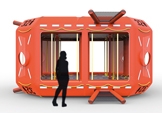Sea Rescue
Mass Rescue at Sea – development of a system for recovery to nearby ships
Summary
The project was carried out in collaboration with the Swedish Sea Rescue Society (SSRS), which is a non-profit organization responsible for approximately 70 % of all rescue operations in Swedish waters. The project was also a part of SSRS’s and Stena Line’s longstanding project FIRST, regarding mass rescue at sea.
The SSRS had identified a need to make use of commercial ships during mass rescue operations, when their own resources are overwhelmed. The aim in this project was therefore to develop a solution that would give these so called ‘ships of opportunity’ a means to efficiently help in mass rescue operations at sea, by recovering people in distress to safety on board.
The project started with extensive background research on the subject, including visits to the most important stakeholders. The research results were analyzed, and eight recovery principle concepts on how to get people from life-rafts to helping ships, was created and evaluated. The conclusion was that relatively small, liftable units combined into a large system was the best solution. These results were compressed into a design brief for a product concept using the chosen recovery principle.
The following product development process was highly iterative. Concepts was presented to, and discussed with, Stena Line and other shipping companies. Discussions were also held with Survitec Group, the world’s largest life-raft manufacturer, during a visit to their factory and R&D department in Belfast, Northern Ireland.
The final concept, a Mass Rescue and Recovery System (MERS) for up to 832 passengers, was presented during the quadrennial World Maritime Rescue Congress in Bremerhaven, organized by the International Maritime Rescue Federation (IMRF) and the German equivalent of SSRS. The MERS system is at the end of this thesis project at a conceptual state, however, intended to be prototyped and tested as soon as possible.
The MERS concept is safe, multi-functional, and efficient.
- Safe: because people in distress can be protected inside the units during the entire rescue process
- Multifunctional: all parts are used for recovery as well as evacuation, there is no need for an additional system.
- Efficient: the first ship at the scene can lift 32 persons at a time, a process SSRS have shown can be done under realistic conditions in just 5 minutes.
The concept could provide SAR personnel and crew with adequate tools to perform their jobs and thus fill a large part of the capability gap in mass rescue operations.
Skriv ut ![]()



